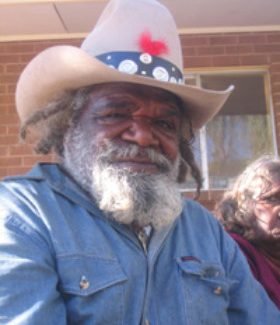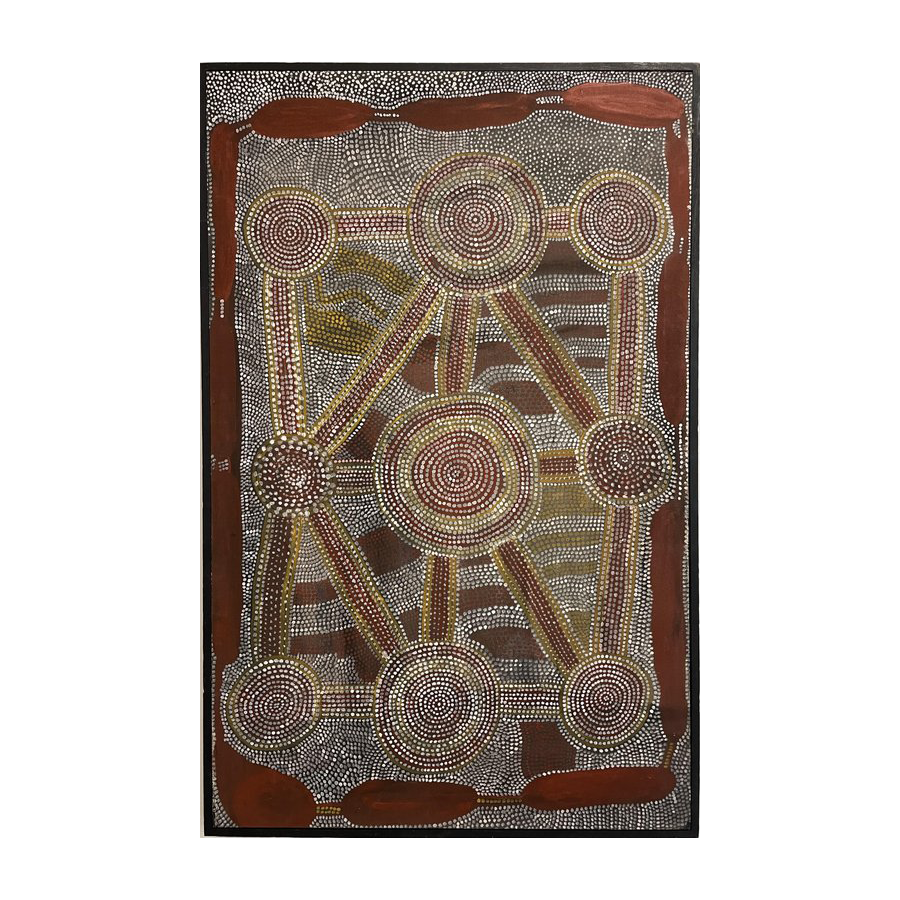RONNIE TJAMPITJINPA
BIOGRAPHY

As a young man of almost 13, Ronnie Tjampitjinpa walked with his family out of the West Australian desert and settled into life in the tumultuous and crowded settlement of Papunya. It was the height of the assimilationist era as the Australia Government oversaw the movement of traditional nomadic people from their Pintupi homelands.
In 1971, at the dawn of the Desert painting movement, Ronnie Tjampitjinpa was in his late 20’s. After attending the European-style school in Papunya he returned to the Western Desert, went through initiation at Umari near his birthplace in the region near Muyinnga, about 100 km west of the Kintore Ranges, spent time in Yuendumu and then returned to live with his relatives in Papunya. There he worked as a police tracker, health worker, and labourer. His earlier tribal initiation into ceremonial knowledge along with his familiarity with country and sacred sites placed him in good stead when he began painting in his early thirties, under the tutelage of Old Mick Tjakamarra. As senior custodian of the Honey Ant Dreaming, Tjakamarra had played an instrumental role in initiating the Papunya art movement. Ronnie was one of the youngest men who began painting in the mid-1970s and his artistic output was initially small as he moved regularly between Papunya, Yuendumu and Mount Doreen Station. As the younger generation no longer lived in close proximity to their traditional homelands painting had become an important means for the older law keepers to pass on their knowledge of sacred sites. Ronnie, having been initiated, became an important participant and mediator in this process.
The classic Pintupi style of linked concentric circles tells of a sacred geometry. It is derived from body paint designs, cartography of country, and ancestral narratives. A consolidating conformity existed between the older painters as they worked out the ground rules for telling the Dreaming while protecting sacred content. Being one of the youngest to begin painting, Ronnie began to demonstrate a more bold and expressionistic approach. Laborious, individual dots evolved into linked or ‘flicked’ dotting and a strong linear emphasis. Distinct iconographic features such as circles and U shapes were relinquished in favour of abstraction and the creation of a vibrant, painterly surface. These developments were encouraged by the return to tribal lands, facilitated by a change in government and Indigenous policies in the late 1970s and early 1980s. Ronnie Tjampitjinpa was a strong advocate for this outstation movement that was given impetus and partly funded by Papunya art sales. During this period, he travelled to Yuendumu, Balgo Hills and Mount Doreen encouraging as many people as he could to return to their traditional Pintupi lands. In 1983 he moved with his family to the small settlement of Ininti-Redbank, near Kintore, and stopped painting for a few years due to his political involvements. This included becoming chairman of the Kintore outstations council and his involvement in important claims for land rights. He had already pioneered new ways of interpreting his ancient visual language and soon returned to painting with new enthusiasm, describing politics as 'too much humbug'. The more focused environment of his own community fueled his distinct aesthetic preoccupation.
In 1984 Tjampitjinpa won the Northern Territory Art Award. This became controversial when other contestants complained that Papunya art was folk art and not worthy of the ‘high art’ title, a strangely persistent attitude in some art circles at that time. The moment became an historic landmark when Judge Nancy Underhill upheld her decision defending his entry, Happening at Mt. Leibig, as genuine art and notably of the highest standard. Demand for Tjampitjinpa’s work grew and his leaning towards painterly abstraction was increasingly favoured and encouraged by the contemporary art market. He emerged as a leading figure, sustaining the boom in the national and international reputation of Aboriginal art during the 1990s.
Ronnie's works first appeared in Papunya Tula exhibitions during the 1970s, and later in commercial art galleries in Sydney and Melbourne throughout the 1980s. He won the Alice Springs Art Prize in 1988 and this was followed by successive solo exhibitions at Gallery Gabrielle Pizzi in 1989 and 1990.
More than any other figure, Ronnie Tjampitjinpa can be credited with having forged a new artistic direction in embracing aesthetic minimalism, thereby freeing up further possibilities for the emerging generation of painters and challenging fixed perceptions of Western Desert art. His hypnotic designs explore interacting geometric shapes which emanate an eye-catching, pulsating action. Still infused with the Dreamings of his mythical Tingari ancestors, Tjampitjinpa refined the characteristic Pintupi simplicity of design, boldly scaling up fundamental pictorial elements, freeing them from their iconographic reference points and strongly emphasizing the distinctive repetition of line and form that has always infused Pintupi art with the spirit of their vast and ancient lands.
From the mid-1990s, Ronnie Tjampitjinpa began painting for a wide array of dealers, only occasionally returning to work with Papunya Tula. Even though Ronnie frequently worked for other dealers, Papunya Tula organised solo exhibitions for him at Alcaston Gallery Melbourne in 1995 and Utopia Art Sydney in 1994,1996, 1997 and 2002. In 2004 he was elected Chairman of the company. His work has been included in major survey exhibitions in Australia and overseas – including a solo retrospective in 2015 at the Art Gallery of NSW – yet he has mostly eschewed the trappings of fame and fortune by dividing his time between working as a painter and performing his ceremonial obligations. Able to earn money wherever he goes, Ronnie is the quintessential modern nomad, familiarly known across a wide expanse of country as he constantly travels in his four-wheel drive with his spears tied on the roof.
© Adrian Newstead
References
Johnson, Vivien, “A History of Western Desert Art”, in Dreamings of the Desert, Aboriginal dot paintings of the Western Desert, Art Gallery of South Australia, Adelaide, 1996. And “Seeing is Believing”, in Papunya Tula, Genesis and Genius, Art Gallery of New South Wales, Sydney, 2000.
Johnson, Vivien, Lives of the Papunya Tula Artists, IAD Press, 2008
Mundine, Djon, “Tribute” in Art and Australia, Vol 35, #3, 1998.
Tradition Today, Indigenous Art in Australia, Art Gallery of New South Wales, Sydney,


